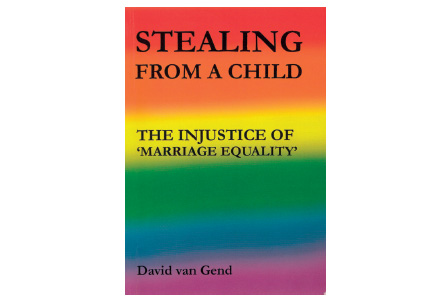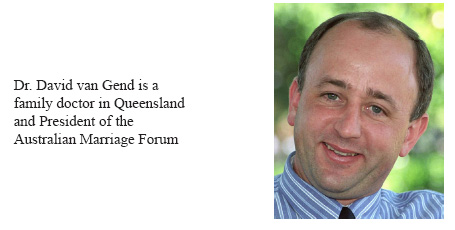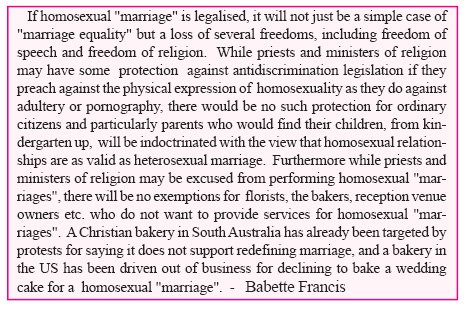BOOK SHELF - "Stealing from a Child: the Injustice of Marriage Equality"
by David van Gend - Review by John Morrissey
 The paperback edition of this book 280 pages, $29.95
plus $3 postage is available from Connor Court Publishing:
sales@connorcourt.com or Ph: 0497 900 685.
ISBN: 978-1-925501-23-0. Reviewed by John Morrissey
The paperback edition of this book 280 pages, $29.95
plus $3 postage is available from Connor Court Publishing:
sales@connorcourt.com or Ph: 0497 900 685.
ISBN: 978-1-925501-23-0. Reviewed by John Morrissey
"This book is about what happens if we enshrine a lie at the heart of our culture" are the opening words of Dr van Gend's exploration of the implications of legalising same sex marriage - especially those for the children. The pretence that there are no consequences aside from a fuzzy public recognition of the love between two people is the lie to which he refers, a lie which reason, honest research and the very words of the proponents themselves have exposed. As the title suggests, van Gend's focus is on the effects on the children who grow up in same sex households, however loving and secure.
He commences with an overview of the implications of this change. It is a subversive plan to deconstruct the natural family by breaking kinship bonds, using education to undermine parents, and curtail the freedoms of speech, conscience and religion, in order to subjugate the family to the authority of the state. Not a great deal different from the ideals of Stalinist Russia? It means choosing a motherless or fatherless existence for some children, imposing LGBTQ sex education on many, silencing all opposition with antidiscrimination laws, and distorting the natural truth of males and females in marriage and parenting.
 Perhaps the most poignant chapter is that quoting the many
children who have grown up in loving and caring same sex
households. They are torn between loyalty to their families
and expressing the pain and loss that they have experienced
from being deprived of their natural right to biological parents
of each sex. Some of the names are already familiar to
us: Katy Faust, Dawn Stefanowicz and Millie Fontana-Fox.
Katy describes her mother as "fantastic" and "an exceptional
parent", and her partner as "an incredible woman",
but adds that while the children of lesbians love their mums,
yet there is a "gut-wrenching longing" for a father.
Perhaps the most poignant chapter is that quoting the many
children who have grown up in loving and caring same sex
households. They are torn between loyalty to their families
and expressing the pain and loss that they have experienced
from being deprived of their natural right to biological parents
of each sex. Some of the names are already familiar to
us: Katy Faust, Dawn Stefanowicz and Millie Fontana-Fox.
Katy describes her mother as "fantastic" and "an exceptional
parent", and her partner as "an incredible woman",
but adds that while the children of lesbians love their mums,
yet there is a "gut-wrenching longing" for a father.
Millie speaks of her happiness in meeting her father at age 11: "I saw my future, I saw my heritage, I saw my other family ... . I cannot believe that LGBTQ is trying to push an agenda that says that my feelings were not important." Millie adds that "a lot of us are just too scared to speak up because what is at stake is a family." It is this conflict of loyalties that allows researchers to report of dependent children in same sex households that they are happy, loved and suffer no deprivation.
The gay population is not as monolithic as the media likes to portray them. Keith and Paddy are two gay men who opposed genderless marriage in Ireland and the bullying of the Yes side. They speak of the implications: putting the rights of adults over those of children, closing businesses and ruining careers, and requiring Catholic schools to teach the government's vision of marriage.
Another same sex-attracted man, Doug Mainwaring, tells of his gay youth, his choice of a traditional marriage and children, his return to a gay lifestyle and what followed. "I eventually came to the conclusion that I had committed a grave injustice against my kids by divorcing my wife and attempting to create a family with another man. They deserved to be raised by their mom and dad under the same roof." He is now reunited with his wife and children, and he and she are happy in denying their sexual impulses - for the children to have a mum and a dad!
All statistically valid population-based studies of same sex households with children tend to reveal the same thing, that is, children with a married mother and father do best, at face value. The sympathetic small sample surveys with anecdotal evidence, based on interviews with dependent children, are flawed by the factors suggested by Katy Faust and others. A critique of the claims in these studies that no disadvantage is suffered was presented by Professor Loren Marks in 2012: he showed that none of the samples in 59 studies was sufficiently random, representative or large. Other critics have noted that most were "convenient samples", drawn from personal community networks or agencies. Given that the spurious 'no difference' findings are endorsed by no less than the American Psychological Association, the implications of Marks' conclusions are far-reaching for the debate.
 Nine separate and valid - that is, large sample and representative
- studies have shown the adverse effects on children in
same sex households, compared with those living with their
married biological parents. These longitudinal studies reveal
poorer academic outcomes and emotional states, such as levels
of ADHD. A major study by Professor Mark Regnerus, involving
2,988 adults, including 248 whose mother or father
had been in a same sex relationship, showed the well-being of
the latter significantly lower than that of the general population.
It must be noted, however, that similar outcomes have been found in all studies of disrupted (ie single, divorced,
blended) families, showing that family structure more than
poverty affects depression, substance abuse, and thoughts of
suicide.
Nine separate and valid - that is, large sample and representative
- studies have shown the adverse effects on children in
same sex households, compared with those living with their
married biological parents. These longitudinal studies reveal
poorer academic outcomes and emotional states, such as levels
of ADHD. A major study by Professor Mark Regnerus, involving
2,988 adults, including 248 whose mother or father
had been in a same sex relationship, showed the well-being of
the latter significantly lower than that of the general population.
It must be noted, however, that similar outcomes have been found in all studies of disrupted (ie single, divorced,
blended) families, showing that family structure more than
poverty affects depression, substance abuse, and thoughts of
suicide.
Nevertheless, a recent study by Professor Paul Sullins showed twice the risk where the disruption involved same sex parents. Naturally, this study has been attacked by such as the APA, but Sullins was able to show that his subjects had reported no stigma to explain the difference, as alleged by his opponents. While the science is settled as to the adverse effects on these children, the cause is not understood, but anecdotal evidence suggests that the effects of repressive gay ideology's emphasis on sex or even sexual abuse itself within these families play a role.
Dr van Gend asks, "Which of our politicians is so negligent, so captive to fashion, so indifferent to the best interests of the child, as to sign such an institution into law?"
After describing the outrages of the LGBTQ "Safe Schools" course and the Federal government's response after George Christensen's revelations in Parliament, the author examines the bullying and "born that way" claims used to justify the program. While the claims have been taken at face value, British and US studies, based on very large samples of children reporting bullying, have revealed a lower incidence among children from same sex households than those who have suffered for more familiar reasons: "too smart, too dumb, too fat, too weak. Too shy, too odd-looking".
Strangely, Australian studies have not identified bullying of gays at school, but only the forms that bullying takes, differentiating the behaviour of girls and boys. The Latrobe University's 2010 All of Us: Writing Themselves In report's 75% claim covered everything from "feeling excluded by peers" (69%) to physical bullying (18%), which were comparable to those in the general school population, but were NOT all obtained from school children. Half were at university or out working, a bias recently conceded by one of its authors. [The methodology implied by the questionnaire included in this chapter would raise eyebrows!]
David van Gend also briefly addresses the "emotional blackmail" which links depression among same sex-attracted young people to stigmatisation, and demands marriage as "therapy". He reminds the reader of stress and health-related issues among gay people, and warns of the psychological harm wrought by the sense of being a victim. "Born that way" is a myth , he argues, quoting Michael Glatze, founder of Young Gay America: "Coming out of homosexuality is the most liberating thing I have ever felt... It doesn't feel as though I have lost any of my sexuality, it just is working in the right alignment."
 A large US study reports that 3 out of 4 young men who had
thought that they were gay at 17, by 25 identified as heterosexual,
and most without going through any therapy. In Australia,
Latrobe University in 2003 published a survey indicating
same and bi-sexual adults at 2.4% of the population. Yet in
spite of these figures and the changeability of sexual orientation,
activists equate "marriage equality" with civil rights for
black Americans.
A large US study reports that 3 out of 4 young men who had
thought that they were gay at 17, by 25 identified as heterosexual,
and most without going through any therapy. In Australia,
Latrobe University in 2003 published a survey indicating
same and bi-sexual adults at 2.4% of the population. Yet in
spite of these figures and the changeability of sexual orientation,
activists equate "marriage equality" with civil rights for
black Americans.
In conjunction with the removal of exemptions for religious institutions, the churches will be put under pressure to collaborate, if same sex marriage is legislated, but far greater persecution has already emerged in Canada especially. Law graduates from a Christian university, Trinity Western, cannot be registered to practise as lawyers, because of a pledge they take to uphold man-woman marriage. The author goes to the heart of the matter when he concludes that the LGBTQ's victory for "marriage equality" has given that lobby the legal high ground to command the rest of the culture war.
The words of the minority four judges on the US Supreme Court ruling on same sex marriage had no illusions about the implications of their colleagues' decision, a weapon to "sully" and "vilify" fair minded people who oppose the new orthodoxy. Religious liberty is about more than protection of religious organisations and people, one explained; it is about freedom of action to exercise religion - their Constitution's First Amendment!
The author also includes a chapter on the gender fluidity notions which are poisoning the minds of children today, showing its connection with the marriage debate. He calls it a kind of Gnosticism, where a presumed superior wisdom redefines nature, to brand male and female as merely social inventions, making the family no longer a "reality established by creation" and making a child merely "an object to which people have a right", as Pope Benedict put it.
There is so much more in these pages than has been conveyed
above, and the book wants only an index to make it
complete. Dr van Gend ends with a modest plea to restore the
"civil co-existence" which prevailed before the march of the
LGBT through our institutions. Above all, he gives those of us
brave enough to defy uninformed public opinion all of the information
we need to expose the real motives of the conspiracy
behind the same sex marriage campaign, together with the
untruths used to sustain it. ![]()
